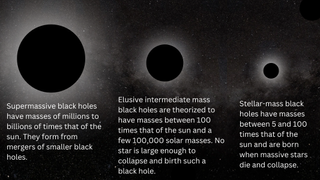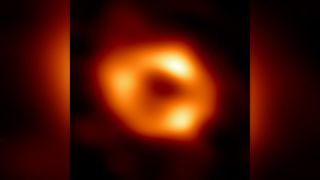Using the Hubble Space Telescope, astronomers have discovered the closest massive black hole to Earth they’ve ever seen, a cosmic titan “frozen in time.”
As an example of the elusive “intermediate mass black hole”, the object could serve as a missing link in understanding the connection between stellar matter and supermassive black holes. The black hole appears to have a mass of around 8,200 suns, making it substantially more massive than stellar black holes, which are 5 to 100 times the mass of the Sun, and much less massive than the aptly named supermassive black holes, which have millions to billions of solar masses. The closest stellar-mass black hole scientists have found is called Gaia-BH1, and it’s just 1,560 light-years away.
The newly found intermediate-mass black hole, on the other hand, resides in a spectacular collection of about ten million stars called Omega Centauri, located about 18,000 light-years from Earth.
Interestingly, the fact that the “frozen” black hole appears to have slowed its growth supports the idea that Omega Centauri are the remnants of an ancient galaxy cannibalized by our own galaxy.
Related: In this simulation, watch a supermassive black hole capture a ‘fluffy’ disk
This would suggest that Omega Centauri is actually the core of a small, separate galaxy whose development was interrupted when it was swallowed up by the Milky Way. If this event never happened, this transient black hole could grow into a supermassive state like the Milky Way’s own supermassive black hole, Sagittarius A* (Sgr A*), which has a mass 4.3 million times that of the Sun and is located is 27,000 light years from Earth.
Searching for what is missing
Scientists have known for some time that not all black holes are created equal. While stellar-mass black holes are known to form from the collapse of stars at least eight times the mass of the Sun, supermassive black holes must have a different origin. This is because no star is massive enough to collapse and leave behind a remnant millions times as massive as the sun.
Scientists therefore propose that supermassive black holes are born and grow through merger chains of progressively larger and larger black holes. This was proven by the detection of ripples in space-time, called gravitational waves, emanating from merging black holes.
This process of merging and growing black holes, combined with the huge gap in mass between stellar-mass black holes and supermassive black holes, means that there should be a population of intermediate-sized black holes.

Still, these intermediate-mass black holes, with masses between a few hundred and a few thousand times the mass of the Sun, appear to have largely escaped detection. That’s because, like all black holes, these mid-sized cosmic titans are marked by outer boundaries called event horizons.
The event horizon is the point at which the gravitational influence of a black hole is so great that even light is not fast enough to escape it. Black holes are thus only visible in the light if they are either surrounded by material they can feed on, which glows when heated, or they tear apart and feed on the unfortunate star in a so-called “Tidal Disruption Event” (TDE).
Medium-sized black holes like the one in Omega Centauri are not surrounded by large amounts of matter and food.
This means that astronomers have to be a little sneaky when hunting for such black holes. They take advantage of the gravitational effects these cavities have on matter, such as the stars that orbit them, or on the light that passes through them. The team behind this new discovery used an earlier method.
Fast star
The hunt for this transient black hole began in 2019, when Nadine Neumayer of the Max Planck Institute for Astronomy (MPIA) and Anil Seth of the University of Utah proposed a research project to improve our understanding of Omega Centauri’s formation history.
In particular, researchers and collaborator Maximilian Häberle, MPIA Ph.D. student, wanted to find fast-moving stars in Omega Centauri that would prove the cluster has a massive, dense, or compact black hole with a “central engine”. A similar method was used to determine the mass and size of Sgr A* using the rapidly moving population of stars in the heart of the Milky Way.
Häberle and team used over 500 Hubble images of this cluster to create an extensive database of stellar motions in Omega Centauri, measuring the velocities of about 1.4 million stars. This ever-repeating look at Omega Centauri, which Hubble took not out of scientific interest but rather to calibrate its instruments, was an ideal data set for the team’s mission.
“Finding high-velocity stars and documenting their motion has been the proverbial needle in a haystack,” Häberle said. In the end, the team didn’t find one but seven “stars in a haystack”, all moving at fast speeds in a small area at the heart of Omega Centauri.

The fast speed of these stars is due to the concentrated mass nearby. If the team found only one fast star, it would be impossible to determine whether its speed was the result of a large and nearby central mass, or whether the star is a runaway moving at a fast pace on a straight path – without any central mass.
This discovery made it possible to detect and measure the different velocities and directions of the seven stars. The measurements revealed a centralized mass equivalent to 8,200 suns, while visual inspections of the region revealed no objects resembling stars. That’s exactly what would be expected if the black hole were located in this region, which the team determined to be “moonlight” wide.
The fact that our galaxy has matured enough to have grown into a supermassive black hole at its heart means that it has likely outgrown the stage where it has many intermediate-mass black holes of its own. This one exists in the Milky Way, the team says, because the cannibalization of its parent galaxy happened to limit its growth processes.
“Previous studies have raised critical questions, ‘So where are the high-velocity stars?’ We now have an answer to that and confirmation that Omega Centauri contains an intermediate-mass black hole,” said Häberle. “At a distance of about 18,000 light years, it is the nearest known example of a massive black hole.”
Of course, this doesn’t really change Sgr A*’s status as the closest supermassive black hole to Earth, or Gaia BH1’s status as the closest stellar-mass black hole to Earth—but it does provide some reassurance that the scientists are right. when considering how our central black hole became such a cosmic titan.
The team’s research was published Wednesday (July 10) in the journal Nature.